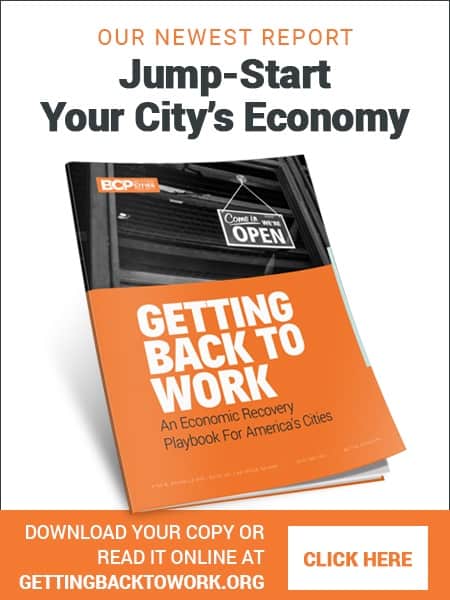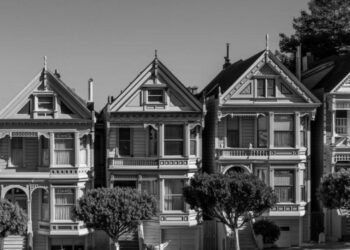At Strong Towns, we like to amplify local wins. Sometimes, that looks like a small business triumphing over arcane parking mandates with the support of the local community. Other times, it’s a motley crew of neighbors coming together to calm traffic in the aftermath of a tragedy.
Sourced from small towns and big cities alike, these stories inspire communities on opposite sides of the country to be the change they want to see. Tactical urbanism in Chattanooga, Tennessee, birthed similar efforts in Denton, Texas. The elimination of parking mandates in one California city of 20,000 compelled another in Minnesota to do the same. A “bike bus” in Oregon has spawned copycats across the country.
These stories showcase that concerted local action can actually catalyze meaningful change. They also offer a counterpoint to the nihilism that empowers larger institutions. The local is where we live, we’ve often written, and therefore local government is a “collection of us.” It’s in our day-to-day lives that we (and our neighbors) experience most acutely the effects of decisions made about how we build and grow our communities.
At the same time, these stories kindle a sort of pessimism among advocates. They want to embrace local government as the highest level of collaboration and themselves as heirs to the legacy of Jane Jacobs, but how can they when localism seems to privilege the opinions of “NIMBYs”? How can they when “local control” is exploited to fortify discriminatory and dangerous norms?
A Vocal Minority
In Pittsburgh, the story goes that the voice of one “notorious citizen activist” outweighed the support of dozens of neighbors when it came to Lawrence Hall, the food hall that took over a long-vacant building in one of the city’s hippest neighborhoods. That activist was able to delay Lawrence Hall’s opening by years, costing the owners thousands of dollars in legal fees, all because the business was four parking spaces short of what Pittsburgh recommended.
Across the country in Seattle, Yonder Bar was looking forward to opening a taproom where patrons could enjoy the company’s eccentric selection of hard ciders. COVID-19 rerouted those plans, however, so founder Caitlin Braam adapted by opening up a walk-up counter for to-go orders out of her garage. It was a hit. The garage-shop garnered a loyal following, and the pivot allowed the company to survive the precarity of the pandemic. By many accounts, this was a pandemic success story.
However, one — exactly one — neighbor wasn’t a fan. This neighbor anonymously filed multiple complaints, questioning Yonder’s proximity to schools and churches, additionally claiming that customers were obstructing access to the sidewalk.
“We have one person who has been calling the city a bunch of times, calling the cops on us a few times, because they don’t like the concept of a bar in their neighborhood,” David Alton, Yonder’s manager, told the local news. “I think they kind of misconstrue what they’re doing here.”
“We have our license, and did everything properly, and are very conscious of who we are and where we are,” Braam added. But the repeated complaints brought increased scrutiny from the Seattle Department of Construction and Inspections, which soon thereafter issued a Notice of Violation.
It didn’t matter that the neighbor’s complaints mischaracterized the business and the realities of its operation. It didn’t matter that Yonder had become a beloved neighborhood fixture. It didn’t matter that the business owners just wanted to “talk it out” with the complaint-eager neighbor. Yonder Bar was forced to shut down. “You can operate a business from your residence if it doesn’t look like a business,” Wendy Shark, a spokesperson with the city of Seattle, said at the time. It’s a law nobody knew existed.
Their predicament in particular struck fear into other small businesses, which, like Yonder, believe they’re operating within their legal right but can never be sure because of ever-changing regulations and no allies in the Department of Construction and Inspections. Apparently, all it takes is one curmudgeonly neighbor to close the book on a small business dream.
A Vocal Majority
On the flip side, when it isn’t the undue influence of a minority, it’s the complete disregard for a vocal majority. The dozens of letters written in support of Dallas’ Slow & Steady Coffee did not compel the board of adjustments to green-light its opening. Instead, owner Germán Sierra could only appease the city’s strict parking mandates by sacrificing part of his structure and amending the stated land use.
On November 10, 2021, when 56-year-old Springfield librarian Gayle Ball was fatally struck while crossing State Street, her colleagues took to the streets. “We are picketing because we were promised a crosswalk from the public parking lot for both employees and patrons who access both the museums and the libraries, because we’ve had multiple deaths on this street from people trying to cross,” librarian Maggie Keane told MassLive.
Ball’s was the third death on State Street that year and the second that month. She was killed in nearly exactly the same place and manner as 7-year-old Destiny Gonzalez in 2014. Two years after her death, on November 14, 2023, State Street would claim another life, that of 68-year-old Michael Cooley. There’s no shortage of Springfield residents demanding something be done — and no shortage of excuses from the city.
Farther south in Philadelphia, the nearly decade-long battle over Washington Avenue still haunts advocates, especially as the stroad has sent nearly a dozen people to the hospital in the last year alone.
Community efforts to slow the five-lane, 80-foot-wide thoroughfare via bump outs, protected bike lanes, and a widened median date back to 2013, but they were ultimately squashed in 2022, despite popular support. In short, one of the two councillors whose district touched the proposed “road diet” rejected the design. In doing so, he demonstrated that the input of the 71% of people who voted in favor of the design in a city-sponsored survey and the 23 community meetings that supported the change were in vain.
That councillor argued that there were holes in the community engagement process. To advocates, it was apparent that even if there were holes, he didn’t care for them. Why would holes negate a decade’s worth of efforts to redesign one of the deadliest roads in the city?
“It is appropriate for the city to be concerned with equity in the community engagement process,” an editorial in the Philadelphia Inquirer stated. “City officials had the option to expand the outreach, to include more voices, and to keep all options on the table. Instead, they tossed out the safest option. The message for the thousands of community members who did weigh in on the future of Washington Avenue is clear: The next time the city asks residents for input, why bother?”
Today, the two halves of Washington Avenue are like fraternal twins. The eastern end is two lanes wide, with curb extensions, bike lanes, and a smattering of flexposts. The western end continues to rack up a death toll. Fittingly, Philadelphia residents noticed that the city no longer claims that it is trying to reach zero deaths by 2030.
How Can We Make It Better?
These examples are as discouraging as they are commonplace. In some of them, our codes are to blame. At the very least, it’s apparent that our codes privilege the status quo over any sort of change.
The aforementioned “notorious citizen activist” in Pittsburgh had the law on his side. He was able to piggyback off of the city’s existing parking mandates. In my own city of Philadelphia, NIMBYs eager to thwart a development take advantage of the built-in bureaucracy of our zoning overlays, which have successfully shrunk projects by several stories in some cases. And how many city streets across the country are mandated to remain wide because of traffic guidelines that prioritize speed over safety?
Reforming (if not eliminating) this patchwork regime governing our built environment would probably be a good first step. It would prevent curmudgeonly neighbors from winning by default. Yet, code is only part of the equation.
Consider that the conversations around State Street in Springfield or Washington Avenue in Philadelphia were ultimatums: Either we will change or we won’t change. And once change is off the table, it’s off for a long time, or at least until reelection when advocates will have a second chance to beat the same drum. What if the approach weren’t all or nothing? What if Washington Avenue’s redesign could be iterative instead? What if city leaders in Springfield were empowered to think smaller and sooner? Perhaps they could’ve prevented 68-year-old Michael Cooley’s death just two years after Gayle Ball’s.
Doing so would change a lot. It would maybe mean that we don’t redesign our deadly streets to completion, but instead we do something, rather than debate the merits of doing anything.
“We don’t hire a consultant. We don’t pause eighteen months while our grant application is processed,” Strong Towns founder Chuck Marohn wrote in 2019. He was putting forward a vision of how we could make our systems work better for and with us. “We’ve humbly identified a struggle and then identified the next smallest thing we can do about it, so we just go out and do that thing,” he continued. “We make things better with what we have now. Right now.”
This thinking is core to Strong Towns. It’s best expressed in the Four Steps to Public Investment:
-
Humbly observe where people in the community struggle.
-
Ask the question: What is the next smallest thing we can do right now to address that struggle?
-
Do that thing. Do it right now.
-
Repeat.
“I’ve always found it a little bizarre that this approach is seen as revolutionary and not merely common sense,” Marohn noted. “After all, does Google just roll out massive changes to Gmail every decade or two? Of course not! They almost continuously roll out incremental changes to small beta groups. They observe how those groups respond to the changes, and then they address any problems. They then roll them out to larger groups. And on and on and on….”
Yet, in the context of our cities, this is revolutionary. But it doesn’t have to be. And in fact, Jersey City is a testament to how our own towns and cities can adopt the four-step process.
How Jersey City Does It Differently
Under the leadership of Director of Infrastructure Barkha Patel and Mayor Steve Fulop, Jersey City has been able to integrate an iterative approach into city planning; namely, by taking a page from the tactical urbanist playbook. In doing so, the city has been able to accelerate changes to its streets not by steamrolling a singular vision in the style of, say, Robert Moses, but by building a response-driven system. The result: Traffic violence has dramatically decreased. In 2022, there wasn’t a single traffic death on a city-owned street.
Part of Patel’s motivation for flipping the script on how her city moves was ensuring that people felt heard. “A year is a really long time from when you make a commitment to a community that you are going to improve some aspect of the pedestrian environment,” she told the Engaging Local Government Leaders podcast back in March. It didn’t have to take a year to fulfill a promise to a community in mourning. And she was in a position to ensure that it didn’t take a year.
Thus, Jersey City became a laboratory. Embracing an iterative process — one where mistakes aren’t avoided but learned from — made the key difference. Patel describes utilizing whatever materials were lying around for semi-permanent interventions like bump outs, curb extensions, delineators, bike lanes, etc. Anyone from emergency responders to school children to the general public would be invited to interact with the proposed changes in the physical realm, rather than debate them in the theoretical one. The response was encouraging.
“We started in areas where there was the most demand for this kind of intervention and soon after, residents in other neighborhoods started to ask for the same changes,” Patel said. “I see that as a good problem to have.”
In bringing conversations about the streets to the streets, residents have the opportunity to talk about how to make changes, rather than whether to pursue them at all.
Even as it endeavors more permanent projects, Jersey City is willing to iterate, rather than build to completion. Newark Avenue, the city’s famed pedestrian mall, is an excellent example. What it looks like today is not the work of a single vision realized in one fell swoop. Instead, it’s the culmination of years of tweaks, additions, improvements and expansions.
At its best, this process wrests the doomsday button away from NIMBYs and instead invites them to interact with the proposed changes. It’s not a process devoid of conflict and dispute. In fact, it’s one that might be seen as chaotic relative to today’s protocols. But today’s protocols aren’t working. They’re costly. They take forever. And they’re killing people.
It’s not like the residents of Jersey City inherently value safety more than the people of Philadelphia, Chicago, Springfield or San Francisco. The city’s drivers aren’t uniquely vigilant, nor are its inhabitants especially predisposed to appreciate tactical urbanism. With a population of nearly 300,000, there’s plenty of room for disagreement.
What sets Jersey City apart isn’t that it’s more likely to come to a consensus. Its government doesn’t look radically different from whatever powers your city. What sets it apart is an approach that any city can replicate. It’s a testament to the idea that local government isn’t the lowest form of government, but the highest level of collaboration.









